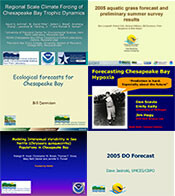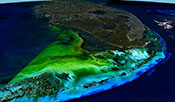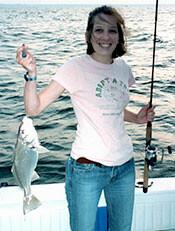Integration and Application Network goals for 2006
 Promote use of conceptual diagrams to synthesize and communicate scientific understanding, and expand the IAN symbol libraries and number of users. Solidify existing partnerships with National Park Service, National Oceanographic and Atmospheric Administration, Department of Defense, Chesapeake Bay Program, Maryland Coastal Bays Program, and create new partnerships. Catalyze synthesis activities with scientists in various locations around the world (e.g., coastal Louisiana), and effectively communicate findings to enhance science applications.
Promote use of conceptual diagrams to synthesize and communicate scientific understanding, and expand the IAN symbol libraries and number of users. Solidify existing partnerships with National Park Service, National Oceanographic and Atmospheric Administration, Department of Defense, Chesapeake Bay Program, Maryland Coastal Bays Program, and create new partnerships. Catalyze synthesis activities with scientists in various locations around the world (e.g., coastal Louisiana), and effectively communicate findings to enhance science applications.
Ecological Forecasting Symposium
 On December 1st, 2005, the Integration and Application Network, in collaboration with the Chesapeake Bay Program’s Tidal Monitoring and Analysis Workgroup, convened a symposium on ecological forecasting in Chesapeake Bay. The symposium included presentations and discussions related to forecasts of dissolved oxygen, harmful algal blooms, aquatic grasses, menhaden, and sea nettles. There was excellent turnout to the symposium, with many UMCES staff attending and presenting their work. As a result of the symposium, it is expected that the Chesapeake Bay Program’s summer forecasts, released in May each year, will be improved by addition of new forecasts (e.g., menhaden) and increasing the accuracy of others (e.g., dissolved oxygen). Presentations given at the symposium can be viewed on the Chesapeaka Bay Program website.
On December 1st, 2005, the Integration and Application Network, in collaboration with the Chesapeake Bay Program’s Tidal Monitoring and Analysis Workgroup, convened a symposium on ecological forecasting in Chesapeake Bay. The symposium included presentations and discussions related to forecasts of dissolved oxygen, harmful algal blooms, aquatic grasses, menhaden, and sea nettles. There was excellent turnout to the symposium, with many UMCES staff attending and presenting their work. As a result of the symposium, it is expected that the Chesapeake Bay Program’s summer forecasts, released in May each year, will be improved by addition of new forecasts (e.g., menhaden) and increasing the accuracy of others (e.g., dissolved oxygen). Presentations given at the symposium can be viewed on the Chesapeaka Bay Program website.
Florida Bay conference
 UMCES scientists traveled to the Florida Keys in December to participate in the Florida Bay and Adjacent Marine Systems Conference. A Scientific Oversight Committee which included three UMCES scientists; Bill Boicourt, Bill Dennison, and Ed Houde, participated in the conference by leading question-and-answer sessions and providing subsequent technical and management review of the quality of research, modeling, and monitoring activities in Florida Bay and the scientific inferences from these activities. In addition, Pat Glibert made a comparative synthesis presentation, contrasting Florida Bay with Moreton Bay, Australia. Conference highlights included the hydrodynamic modeling of the complex interactions between Florida Bay and the Everglades, Gulf of Mexico, and Florida Keys, unraveling the cause of a mysterious seagrass die-off in the 1980s, Hurricane Katrina impacts, and benthic biofiltration by sponges.
UMCES scientists traveled to the Florida Keys in December to participate in the Florida Bay and Adjacent Marine Systems Conference. A Scientific Oversight Committee which included three UMCES scientists; Bill Boicourt, Bill Dennison, and Ed Houde, participated in the conference by leading question-and-answer sessions and providing subsequent technical and management review of the quality of research, modeling, and monitoring activities in Florida Bay and the scientific inferences from these activities. In addition, Pat Glibert made a comparative synthesis presentation, contrasting Florida Bay with Moreton Bay, Australia. Conference highlights included the hydrodynamic modeling of the complex interactions between Florida Bay and the Everglades, Gulf of Mexico, and Florida Keys, unraveling the cause of a mysterious seagrass die-off in the 1980s, Hurricane Katrina impacts, and benthic biofiltration by sponges.
An integrated assessment approach described in recent publication
 A recent article in Environmental Management (36(5): 757-771) by Francis Pantus and Bill Dennison describes an approach for using a suite of ecosystem health indicators to quantify and evaluate ecosystem health in Moreton Bay, Australia. A conceptual diagram of ecosystem health indicators using IAN symbol libraries was developed to establish the role of the indicators in key ecological processes. A spatially intensive monitoring program was created to assess indicators using in situ and remote sensing approaches. Spatial analyses were used to create maps of each ecosystem health indicator (phytoplankton concentrations, nutrient levels, water clarity, seagrass distribution, harmful algal bloom distribution and sewage plumes mapped through stable isotope incorporation into bioindicator organisms). The ecosystem health indicators were then combined into an ecosystem health index map (with associated uncertainty maps) and publicly-disseminated environmental report cards developed from these maps.
A recent article in Environmental Management (36(5): 757-771) by Francis Pantus and Bill Dennison describes an approach for using a suite of ecosystem health indicators to quantify and evaluate ecosystem health in Moreton Bay, Australia. A conceptual diagram of ecosystem health indicators using IAN symbol libraries was developed to establish the role of the indicators in key ecological processes. A spatially intensive monitoring program was created to assess indicators using in situ and remote sensing approaches. Spatial analyses were used to create maps of each ecosystem health indicator (phytoplankton concentrations, nutrient levels, water clarity, seagrass distribution, harmful algal bloom distribution and sewage plumes mapped through stable isotope incorporation into bioindicator organisms). The ecosystem health indicators were then combined into an ecosystem health index map (with associated uncertainty maps) and publicly-disseminated environmental report cards developed from these maps.
New IAN Personnel
 In December 2005, the EcoCheck project (UMCES-NOAA partnership) hired Caroline Wicks to be their Science Applications Coordinator, a position located at the Cooperative Oxford Laboratory in Oxford, Maryland. In this position, Caroline will produce a range of science application products related to, or resulting from the partnership's development of ecological assessment and forecasting techniques. Caroline grew up in Lansdale, PA, and completed her Bachelor of Science in Biology (with a minor in French) at UNC - Wilmington in Wilmington, North Carolina. She then came to Horn Point Laboratory for her Master's degree with Dr. Evamaria Koch on the effects of sediment characteristics on seagrass colonization and distribution along retreating marsh shorelines. In addition to being a scientist, she wants to do more environmental outreach and education. Caroline's interests outside of work include reading, gardening, traveling, and spending time with her family and friends.
In December 2005, the EcoCheck project (UMCES-NOAA partnership) hired Caroline Wicks to be their Science Applications Coordinator, a position located at the Cooperative Oxford Laboratory in Oxford, Maryland. In this position, Caroline will produce a range of science application products related to, or resulting from the partnership's development of ecological assessment and forecasting techniques. Caroline grew up in Lansdale, PA, and completed her Bachelor of Science in Biology (with a minor in French) at UNC - Wilmington in Wilmington, North Carolina. She then came to Horn Point Laboratory for her Master's degree with Dr. Evamaria Koch on the effects of sediment characteristics on seagrass colonization and distribution along retreating marsh shorelines. In addition to being a scientist, she wants to do more environmental outreach and education. Caroline's interests outside of work include reading, gardening, traveling, and spending time with her family and friends.